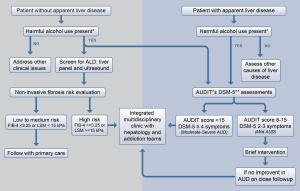 Reviews To Read – February 2022.
Reviews To Read – February 2022.
Published in Lancet Gastroenterology and Hepatology and Coauthored by Lorenzo Leggio of the NIDA IRP Clinical Psychoneuroendocrinology and Neuropsychopharmacology Section.
Despite its increased recognition as a major public health issue, alcohol use disorder is mostly underdiagnosed and undertreated. The undertreatment and underdiagnosis of alcohol use disorder is most concerning in the management of patients with alcohol-associated liver disease, which is one of the main medical consequences of chronic and excessive alcohol use. Dual pathology (alcohol use disorder and alcohol-associated liver disease) requires multidisciplinary care involving hepatologists and addiction specialists. Such integrated care models are widely accepted as optimal care for treating comorbid medical and mental health conditions. However, the implementation of such models in clinical practice is challenging and often represents the exception, rather than the rule, in managing patients with alcohol use disorder and alcohol-associated liver disease. Barriers at the patient, clinician, and system levels are encountered in treating patients with alcohol use disorder and alcohol-associated liver disease. In this Viewpoint, we synthesise the emerging literature on the potential barriers encountered in caring for patients with alcohol-associated liver disease and alcohol use disorder and focus on how integrated models of care could overcome these barriers. We provide our perspective on why these barriers exist and propose strategies to overcome them.
Barriers to the management of alcohol use disorder and alcohol-associated liver disease: strategies to implement integrated care models Journal Article
In: Lancet Gastroenterol Hepatol, vol. 7, no. 2, pp. 186–195, 2022, ISSN: 2468-1253.
